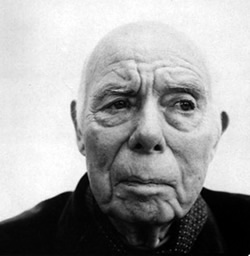Jean Renoir (1894-1979)
 The son of artist Pierre Auguste Renoir, Jean Renoir had an elite education at boarding schools (from which he ran away). He served and was wounded in WW I. He started making films in the 20s.
The son of artist Pierre Auguste Renoir, Jean Renoir had an elite education at boarding schools (from which he ran away). He served and was wounded in WW I. He started making films in the 20s.
Politically, Renoir was, associated with the Popular Front (an alliance of left wing movements that rose to power in France in the mid-1930s).
He fled to the US in 1940 and made films in Hollywood, but was not particularly successful. He had better luck after his return to France in the 50s.
Critics often describe Renoir as a bitter and melancholy satirist who depicted the hollow nature of both human lives and institutions. However, his attitude is a good reflection on Europe in the late 1930s when Renoir made his most famous films. Renoir's vision of impending catastrophe was exactly on target.
Renoir's work emphasized binary distinction, particularly nature/culture. This is often portrayed with indoor/outdoor shots. This has a deep correspondence with French anthropology which was also concerned with binary distinction, particularly the sacred and the profane. Renoir was deeply influenced by painting, other visual art. In Renoir's work, the visual techniques of the film heighten the psychological reality experienced by the characters.
Renoir's work in the 1930s focuses on the crumbling of European society and social structure and the loss of earlier meanings. His most famous works of this era are Grand Illusion (1937) and The Rules of the Game (1939). Both are frequently ranked among the best movies of all time (though TRTG was not originally well reviewed).
Andre Bazin (important later in this course) described Renoir's work as "poetic realism." He noted that Renoir's work focused on the interplay between the individual and society, particularly the ways in which the fates of individuals are determined by the roles they must play.
Next: The Rules of the Game
Next: Grande Illusion